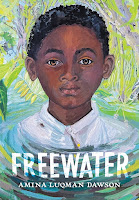1 February 2022, Little Brown Books for Young Readers
E ARC provided by Edelweiss Plus
Homer and his sister Ada are enslaved people on the Crumb's Southerland Plantation. Their mother, Rose, works in the house with Nora, the daughter of the owners, who has a strawberry birthmark on her face and has chosen not to speak, so is largely ignored by her family. When their mother planned to run away North, Homer did not want to leave his friend, Anna, behind, so the mother went back for her. When the mother did not return, Homer decided to go North with his sister alone. They were chased by Stokes, the overseer, but managed to get deep into the swamp, where they are aided by Suleman and taken to a hidden community made up of people who have also escaped plantations. Sanzi, a young girl who has been raised in this community, welcomes the new children, but is interested in how they could help provide for their tools or supplies for Freewater. Back at Southerland, everyone is preparing for a wedding. Anna and Nora both have plans for escape, some of which involve trying to use an herbal elixer to sedate the attendees. Homer also has a plan to go back to the plantation and to use the event to help his mother escape, and Suleman and Sanzi agrees to help, but mainly for their own reasons. With bounty hunters clearing land near the Freewater community and sends groups with dogs to search for runaways, will Homer, his family, and his new community be able to withstand so many threats?
Strengths: I had never heard of communities of former enslaved people living in the Great Dismal Swamp, and it's always good to see unknown history highlighted. There is enough description of life on the plantation and the poor treatment of the residents that even students who are not familiar with this time period as they should be will get a better understanding of why communities like Freewater existed, since living in the middle of a swamp was not a pleasant experience. Homer's dedication to his family, and his determined attitude to escape and make a life for himself and his sister will resonate with young readers who want to work against injustice.
Weaknesses: Nora was an interesting character, but there were so many plot threads going on that her experiences could have been minimized. The treatment of white people who were different was interesting to see, however, and I could see why the author included this character. 416 pages is just a bit long for most middle grade readers.
What I really think: This is an interesting fictionalized version of historical communities that have not been discussed in middle grade literature, and about which little is known. The author does a good job of creating a likely historical world and exploring the different circumstances that would have driven people there. A good addition to books like Christopher Paul Curtis' The Madman of Piney Woods and Rhodes' Sugar, both of which deal with historical effects of slavery but are written by Black authors and do not center the white experience, as so many titles from years past do.
Weaknesses: Nora was an interesting character, but there were so many plot threads going on that her experiences could have been minimized. The treatment of white people who were different was interesting to see, however, and I could see why the author included this character. 416 pages is just a bit long for most middle grade readers.
What I really think: This is an interesting fictionalized version of historical communities that have not been discussed in middle grade literature, and about which little is known. The author does a good job of creating a likely historical world and exploring the different circumstances that would have driven people there. A good addition to books like Christopher Paul Curtis' The Madman of Piney Woods and Rhodes' Sugar, both of which deal with historical effects of slavery but are written by Black authors and do not center the white experience, as so many titles from years past do.


























No comments:
Post a Comment